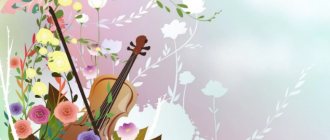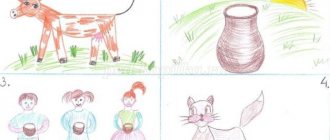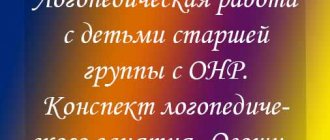Equipment for classes in kindergarten:
- record player,
- audio cassettes,
- children's musical instruments,
- doll - “conductor”,
- portraits of composers (F. Schubert, J. S. Bach, F. Chopin),
- album with photographs of musical instruments,
- screen,
- sultans.
Repertoire:
- “Dance” by F. Schubert;
- “The Joke” by J. S. Bach;
- “Waltz No. 17” by F. Chopin;
- organ music by J. S. Bach;
- musical and didactic game “Musical Instruments”;
- sedentary game "Orchestra".
____________________________ NOTE - You can buy toys for kindergarten in the specialized store "KINDERGARTEN" - detsad-shop.ru Low prices, discounts for kindergartens and children. committees, delivery!
____________________________
Lesson summary “Instruments of the Russian folk orchestra”
Lesson topic No. 26:
"Instruments of the Russian folk orchestra"
Lesson objectives:
—
familiarization with Russian folk instruments, broadening one’s horizons;
—
the formation of a sustainable interest in Russian folk art, the music of the Russian people;
- develop creative thinking.
Equipment:
presentation “Folk Instruments”; a record with the recording “The Moon Is Shining”; folk musical instruments: balalaika, spoons, tambourine, drum, triangle, button accordion.
Progress of the lesson:
1.Organizing time.
2.Message about the topic of the lesson
—
What do you think the first musical instrument was? Perhaps it was a tree with a hollow. Primitive man hit it, and the tree began to sound. At first the man was frightened - the sound did not at all resemble either his own voice or the cry of the beast. But then I got used to the unusual tree. It's good to be the owner of an unusual instrument that sounds the way you want! The man hit it, now speeding up, now slowing down. Of course, you can’t play a melody on it, but you can give a signal. True, to do this I had to go to my tree every time. And the primitive musician made a smaller instrument to take with him. He took a piece of wood and hollowed it out. By that time, the ancient musician had already realized that hollow objects, when struck, emit sound. And one day, at dinner, a man blew on a bone and a whistle sounded. Of course, this was purely an accident! The sound was like a bird whistle. Can a hollow bone and a piece of hollowed wood really be considered musical instruments? It turns out that it is possible! This is how the melody appeared, and along with the melody - musical instruments. And although many, many years have passed since then, all instruments known in our time are divided into three groups: strings, winds and percussion. We will talk about them today.
3. Main part
1) Show a presentation with the teacher’s story
1) Gusli
Slide number 1 Riddle. And Sadko played them and sang soulfully, He went through many strings, Neptune came out of the sea.
— What musical instrument are we talking about? - What does the word “harp” mean? — Stage of development of the gusli (Gusli-psalter, ensemble varieties of gusli). Gusli
- an instrument that is a flat, hollow box with strings stretched over it. The upper deck of the gusli was usually made from sycamore (white maple), hence the expression “yavorchaty” or “yarovchaty”. A musical example of playing the gusli (N. Rimsky - Korsakov “Play, my gusli”).
2) Balalaika Slide No. 2 Riddle. It has three strings, you have to pluck them with your hand, you can dance to it and squat in Russian.
-What instrument is the riddle talking about? balalaika mean in ancient times?
? Related to the words babble, babble, joke. A musical example of playing the balalaika. (Variations on a theme
Russian folk song "Kalinka")
3) Pipe Slide No. 3
Mystery. And the shepherd plays on it And gathers the sheep, Pew-pew-pew, Pew-pew-pew, We go to the shepherd.
— What musical instrument are we talking about? Research on the history of the instrument. Pipe
-Russian folk instrument, most often representing paired wooden pipes with whistles and side holes (whistle flute). Made from buckthorn, hazel, maple or bird cherry. A musical example of playing the pipe sounds
4) Horn Slide No. 4 Riddle.
We gathered a round dance. All the people were invited, and the shepherd's horn complements our circle. The horn is a conical-shaped straight pipe with five playing holes on top and one on the bottom. There is a small bell at the lower end, and a glued-in mouthpiece at the upper end.. A musical example of playing the horn.
5) Pitiful Slide No. 5 Riddle. Carved in the forest, smoothly hewn, sings as if complaining. What is the name of?
-Pity. Russian folk wind instrument: a reed or wooden tube with a simple or single reed and side holes. The lower end of the tube is often inserted into the cow's horn, serving as a resonator. What is the reason for the homogeneity of the roots “zhaleika” and “zhalnik”?
6) Tambourine Slide No. 6 Riddle I’m all round, If you hit me, I sound like bells, If you put me down, I’m silent!
-What percussion instrument do you think is mentioned in the riddle? The tambourine is a percussion instrument of indefinite pitch. A wooden hoop covered with leather on one side; metal plates are loosely attached in pairs to the holes of the hoop.
7) Ratchets Slide No. 7 Riddle A folk musical instrument, its name is connected with magpies. Every person who has even a small calling can own it! Ratchets are a Russian folk percussion instrument; a series of planks (up to 20 or more), separated by narrow strips and strung on a strap.
8) Spoons Slide No. 7 Riddle -What percussion instrument can you use to slurp cabbage soup?
Spoons are Russian folk percussion instruments, consisting of two ordinary spoons. In the old days, bells were tied to spoons. A play set of spoons may include 2, 3 or 4 medium-sized spoons and one large spoon.
2) Consolidation of acquired knowledge . Children are given percussion noise instruments: spoons, rattles, tambourines. Variations on the theme of the Russian folk dance song “Barynya” will be performed by an ensemble of Russian folk instruments under the direction of Peter Muzyka. Children's participation in the performance of the piece.
4. Summing up the lesson - Which Russian folk instruments are stringed?
wind, percussion?
Program content:- Introduce children to the history of the origin of the folk musical instrument - the gusli.
- Expanding musical horizons, developing cognitive interest in music.
- Development of auditory and visual attention, emotional responsiveness to music.
- Develop gross and fine motor skills.
- Develop musical abilities (modal sense, musical-auditory perception, sense of rhythm).
- To form the foundations of singing and general musical culture (aesthetic emotions, vocal and choral skills).
- Teach children to perceive the development of musical images and express them in movements, to coordinate movements with the nature of the music.
- Form beautiful posture, teach expressive, plastic movements in the game.
Preliminary work
:
Children listen to an audio recording of a musical production based on the Novgorod epic “Sadko and the Sea Tsar” and the opera by N.A. Rimsky-Korsakov "Sadko".
Progress of the lesson
Since ancient times, people have been listening to music, and music, as we know, is performed on musical instruments.
Now choose and name the musical instruments that are familiar to you. They sang epics they composed about the heroic deeds of Russian heroes, accompanying themselves on the harp. Some of these epics have survived to this day. One of them is already familiar to you. It's called "Sadko". Who is Sadko? Show me how you will play the harp? And now I will play the piano, and you will play the harp. Guys, our lesson has come to an end. What do you remember from our lesson? And now I say goodbye to you, goodbye! Children enter the hall and say hello.
Music director:
I am glad to see you again at the music lesson.
Look, today we have an exhibition of musical instruments in our hall, walk through the exhibition and look. (To the music of A. Rubinstein “Melody”, children look at the drawings).
Music hands:
Children's answer.
Music hands:
I'll tell you a riddle, and you try to guess it.
He plays the button accordion, the piano, the guitar. He is a famous talent. Who is this?
Children:
Musician!
Educator:
You and I will be musicians, let's see how our little finger helpers can play instruments.
Children perform:
We came and stood up and played the pipes. Doo-doo-doo... (They walk in place. Imitating playing the pipe.)
We came and stood up and started playing the drum.
Tra-ta-ta... (They walk in place imitating playing the drum.)
We came and stood up on the balalaika and started playing.
La-la-la... (They walk in place. Imitation of playing the balalaika.)
We came and stood up and started playing the harmonica.
Ti-li, ti-li, ti-li... (They walk in place. Imitation of playing the harmonica.)
Music hands:
Well done boys! Now come everyone to me. (Children stand in a semicircle near the piano)
Music hands:
Now we will wake up our voice and sing the song “Musician”
Song: “Musician”
Music hands:
In previous lessons, we learned a song by composer V. Semenov. What is it called?
Children's answer.
Music hands:
I suggest you sing it now. How are we going to implement it?
Children's answer.
Song: “Little Musicians” music. V. Semyonova
(Children sit down)
Music hands:
What do you think the first musical instrument was? Perhaps it was a tree with a hollow. Primitive man hit it and the tree began to sound. At first the man was a little scared - the sound did not at all resemble either his own voice or the cry of the beast. But then I got used to the unusual tree. The man hit it, now speeding up, now slowing down: boom, boom, boom! Boom Boom! And although many, many years have passed since then, in our time there is a great variety of musical instruments. But I will tell you about an ancient Russian instrument, the gusli.
The ringed harp is the oldest and simplest.
The very first performers on the gusli were buffoons. Who are the buffoons? Children's answer.
(There's a knock on the door, a buffoon comes in with a harp in his hands)
Music hands:
And here the buffoon himself came, with his ringing goslings.
Buffoon:
Hello guys! I am a cheerful, daring fellow, and I brought with me a ringing, spring-shaped harp to visit you.
Music director:
Show us buffoon how you play the harp?
Buffoon:
I place the harp on my knees and pluck the strings with my fingers one by one.
(R.N.M. plays the harp. “In the garden or in the vegetable garden.”)
I go to holidays, fairs, amuse the people, play the harp.
Music Hand:
In ancient times, guslar singers also came to the holidays
.
Children's answer.
Music director:
Sadko was a guslar and a sailor, he dreamed of the happiness of all people, so he went on a long sea voyage to look for the bird of happiness. And the great Russian composer N.A. Rimsky-Korsakov wrote an opera, which he also called “Sadko”. And now we will watch and listen to Sadko’s song from the musical fairy tale “Sadko”.
Excerpt from the video of the film “Sadko”
Song: “Oh, you dark oak tree”
Music director:
What impression did this song make on you?
What is the mood of this song (lingering, thoughtful, melancholy, melodious)
? Why the sad mood? And the mood is sad, sad because Sadko sings it far from his home. Composer Rimsky-Korsakov is very close to this mood, because even before becoming a composer, he was also a navigator, and due to his duty, he often had to be separated from his loved ones. And now I’ll play you some music called Gusli” by composer V. Vitlin. Listen to how the composer conveyed the sound of the gusel on the piano.
«Gusli” Music. V. Vitlina
Music hands:
Is the melody similar to the sound of a gusel?
What is the nature of the music (light, iridescent, ringing)
? We listened to Sadko's song. Who is its composer? Who wrote the music for Gusli? Who remembers the composer's name? Let's compare them. Are they similar in sound and mood? It also seems to me that this music conveys the same feelings of sadness and sadness. Today I have prepared a harp for you and you will be a harpist.
(The teacher distributes flat harps to the children.)
(Music by V. Vitlin “Gusli” is repeated)
Musical director: (to the buffoon)
Did you, Buffoon, like how the children played?
Buffoon:
I listened. What wonderful music, what magical sounds!
Educator:
And I, guys, want to invite you to play a game called “Guslyar”.
Buffoon:
Can you guys teach me how to play?
Children's answer.
Game: “Guslyar” Russian folk melody “Kalinka”
(Children stand in a circle and pass the harp to each other. At the end of the music, whoever has the harp in his hands is the harp player. The child goes into the circle and plays the harp. All children perform familiar dance movements).
Music director:
(Children leave the hall to the music).
“Musical instruments”. Non-traditional drawing technique
Program content:
1. Cultivate interest in music, respect for musical instruments, the ability to listen, feel music, and experience it.
2. Develop children's creative abilities.
Materials:
a letter from Dunno, a sheet of cardboard, a pencil, gouache, a brush, semolina (for each child), an audio recording of music and musical instruments.
Progress of the lesson
1 part. From the history of musical instruments
Children enter the group and sit on chairs. Calm music sounds.
Educator: Guys, listen, what do you hear now? (Children's answers.)
Do you like music?
Which one? (Children's answers.)
This morning I found a letter from Dunno in my mailbox, let's read it:
(reading the letter)
. Well, guys, let's help Dunno?
Today we are waiting for you on an exciting journey into the world of music. When do you think music and musical instruments appeared? (Children's answers.)
Guys, music originated a long time ago. Even in ancient times, many legends were composed about the origin of music. The ancient Greeks believed that music was given to them by the gods. Scientists, based on research, have established that music appeared in primitive society. For ancient people, it was associated with everyday life. The woman hummed, rocking the children, the shepherds called the flock with the sound of horns. In primitive music there were many onomatopoeias: the songs repeated the sounds of the surrounding world - the cries of wild animals and birds. The main element was rhythm. He helped people perform movements clearly while working. Singers emphasized the rhythm by clapping or stamping their feet. Later, people noticed that flat stones, pieces of wood, and shells made loud sounds when struck. They became the first musical instruments.
Let's play the game "What does it sound like?"
I'll play the recording for you, and you have to guess what musical instrument you hear:
I turn on the audio recording, the children guess what kind of instrument it is (drum, violin, balalaika, pipe).
Do you know where these types of musical instruments came from? (Children's answers.)
Strings - from a hunting bow, winds - from a shell, horn, reed. But the most venerable age belongs, of course, to percussion instruments: they arose among primitive people, who began to accompany their dances with the rhythmic striking of one stone against another. Gradually more advanced musical instruments appeared. It turned out that if you stretch the skin over a hollow wooden or clay object, the sound will become louder and stronger. This is how the ancestors of the drums were born.
Guys, unfortunately Dunno did not know all this, since he was not with us on the trip. Let's draw musical instruments for him as a souvenir and send it by letter.
2 practical part. Drawing with semolina
Take a seat at the tables. You see on them a sheet of cardboard, a pencil, gouache, a brush, glue and semolina on a plate. Now each of you will draw the musical instrument that you want. I remind you of the rules for drawing with semolina:
1. First, draw a drawing on cardboard with a pencil.
2. We outline our drawing with PVA glue.
3. Take semolina and scatter it over the pattern, with glue already applied.
4. When the glue dries a little, you need to shake off the excess semolina.
5. Give a little time for the cereal to stick and paint the drawing using the poking method (on the cereal).
All clear? Then let's get our fingers ready.
Finger game. Dwarves' treat
The gnomes began to invite guests. ( Alluring movements with both hands
.)
The gnomes began to treat the guests. ( Shake hands several times: alternately with the right and then the left hand on top
.)
Each guest got jam. ( The index finger of the right hand “spreads” imaginary jam on the fingers of the left hand: from base to tip
.)
My fingers were glued together by that treat. ( Sequentially, starting with the little fingers, connect the pads of the same fingers of both hands
.)
Palm pressed tightly to palm, ( Accordingly
.)
Guests cannot even take spoons! ( An adult checks how tightly the baby’s palms are “stuck together” and pulls him by the elbows to the sides
.)
Now get started... (children draw).
Well done! Look what wonderful musical instruments you have made. Dunno will really like them.
Reflection
Well, our journey has come to an end. Did you like it? What new did you learn today? (children's answers.)
Now let's dance a little. Stand in a circle.
The children dance to the music “If you like it, then do it this way.”



